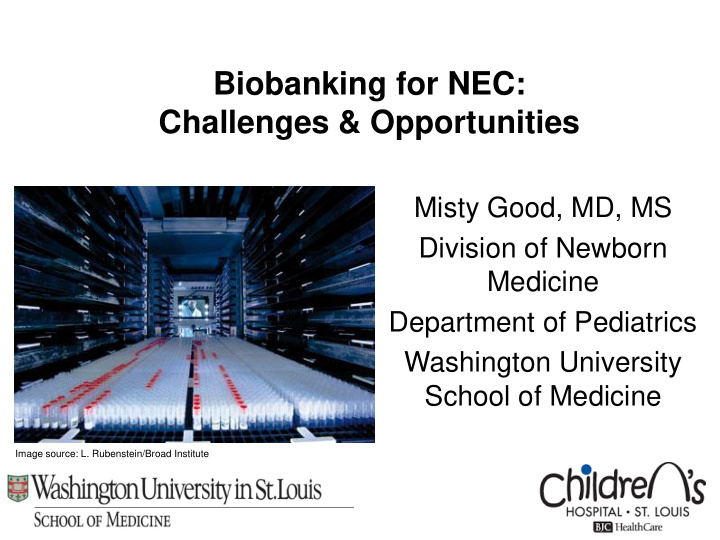



Biobanking for NEC: Challenges & Opportunities Misty Good, MD, MS Division of Newborn Medicine Department of Pediatrics Washington University School of Medicine Image source: L. Rubenstein/Broad Institute
Audience Poll • Raise your hand if your center collects samples from babies with NEC? Image source: Susies Heart Photography
Objectives • Discuss the purpose of the biorepository • Define samples interested in collecting • Discuss infrastructure for biorepository • Review database capabilities • Discuss specimen procurement • Review funding opportunities • Discussion Image source: UC Davis Health
Biorepository • Definition: Biologic materials repository that collects, processes, stores and distributes biospecimens to support future scientific investigation. • Purpose: To maintain biological specimens and associated info for future use. • Biorepository assures the quality and manages the accessibility and distribution of the samples. Image source: Pediatric Research Alliance
NEC Biorepository • NEC Society Meeting UC Davis April 2017 • Focus group convened to discuss interest, challenges, and opportunities • This group has a shared vision to advance the state of the science to combat NEC Image source: Univ of Chicago Science Life
Biorepository Aims • Aim 1: Develop and maintain a NEC specimen biorepository with linked clinical metadata accessible to investigators across multiple institutions within/outside the US. • Aim 2: Develop and maintain the infrastructure to execute large observational studies utilizing NEC specimens across multiple institutions within/outside the US.
Biorepository Aims • Overarching goal: To promote, facilitate, and accelerate basic and clinical- translational observational studies of NEC in humans. Image source: EPL Archives Biorepository
Who is involved? • A team of investigators dedicated to advancing the field of NEC research. • Several investigators from the NEC Society Research Collaborative. Image source: Pediatric Research Alliance
What are centers currently collecting? • Several centers currently collecting: – Intestine – Stool • To a lesser extent: – Blood – Urine • Rarely: – Gastric aspirates – Saliva – Maternal breast milk Image source: petpookiddos.com
What are we interested in collecting? • Blood, stool, and intestine • Intestine only • Blood and stool • Stool and intestine • All the bodily fluids listed on previous slide Image source: MUSC
What are we interested in collecting? • All the bodily fluids listed on previous slide Image source: MUSC
Infrastructure • IRB approvals , standardized informed consents and protocols • Research coordinator and/ or staff for consenting • Surgeons/pathologists on board • Team of tissue collectors with access • SOPs : Specimen notification • SOPs : Tissue/sample handling Image source: Gencure.org
Tissue Procurement • Intestinal resections for NEC and “Non - NEC” tissue from stoma closures, atresias, SIPs, strictures. • Detailed procedures for tissue procurement, processing and storage are required.
Intestinal Resection SOP • Once the resection comes into lab, it is cut up and banked as below: – RNA later for gene expression studies stored at -80 – 4% PFA for histology, processed and sectioned – Snap frozen for microbiota 16S stored at -80 – Snap frozen for a backup sample stored at -80 – Snap frozen piece for Repository – Rest is processed fresh for ex vivo studies (i.e. isolating intestinal stem cells, making enteroids, etc.)
Other Specimens • Blood • Urine • Stool • Gastric or tracheal aspirates • Breast milk • Saliva – All stored in -80 Image source: ITOR Biorepository
Infrastructure • Equipment: Dedicated freezers with temp monitoring, centrifuges • Consumables: PPE, surgical instruments, tubes, racks, boxes, RNA later, formalin • Training and Compliance: CITI modules, HIPAA, BBP • Archiving system: Database, labeling, access to PHI
Infrastructure • Archiving system: Barcoding system for ease of locating and specimen retrieval • Freezers: Secure with alarms and procedures in place for loss of electrical power, minimize access Image source: L. Biologix Image source: L. Rubenstein/Broad Institute
Infrastructure • Strict case definitions: Review by site PIs and research coordinators • Consenting: Standardized, rapid • Recent scrutiny surrounding saving samples • No consent: If parents unavailable, ability to acquire NEC tissue fresh or stool until parents are available within 24 hrs
How do we start? • Setting up the infrastructure . • Multi - center IRBs for the virtual biorepository, database and sharing of samples/information between centers. Image source: Sterling IRB
Database • Using REDCap database for clinical information since it’s free and accessible everywhere. Image source: MiFID II
What is REDCap? • Research Electronic Data Capture • A secure web application designed to support data capture for research studies. • REDCap allows users to build and manage online databases quickly and securely. • Developed at Vanderbilt University; used by >2000 institutions. • Many centers are already using it and their CTSIs provide support on REDCap.
REDCap • For more information on REDCap: http://project-redcap.org/
Accurate Recordkeeping • Finalize clinical parameters to be obtained – Birth, feeding, antibiotic, drug, transfusion history • Data repository quality – Timely entering of data after samples obtained • International collaborations Image source: Northwestern
Material/Data Sharing • Investigators from all centers able to collaborate with the NEC Society Biorepository – Collaboration with a participating center required • Application will be available online through the NEC Society website • Biorepository scientific advisory board will review applications
Biorepository Maintenance • Funding – Each center to obtain their own? – Internal, NIH, Foundations, PCORI • Protection of confidentiality across all centers – Anonymous coding – Minimize individuals with access to coding identifiers Image source: Air Cargo World
Summary • NEC Society investigators are committed to the development of a national/international biorepository of biological samples from infants afflicted with NEC. • Goal is to improve human specimen studies by individual NEC investigators and foster collaborations across multiple centers.
Summary • It is the hope of all involved in the NEC Society Biorepository that we can improve, facilitate, and accelerate basic and clinical/translational studies of NEC.
Acknowledgements • NEC Society for bringing all the investigators together for this amazing collaborative. • Jennifer and Dr. Noah Canvasser
Thank you for your attention! Questions? Interested in being a part of the NEC Society Biorepository?? Email: mistygood@wustl.edu jennifer@necsociety.org
Recommend
More recommend